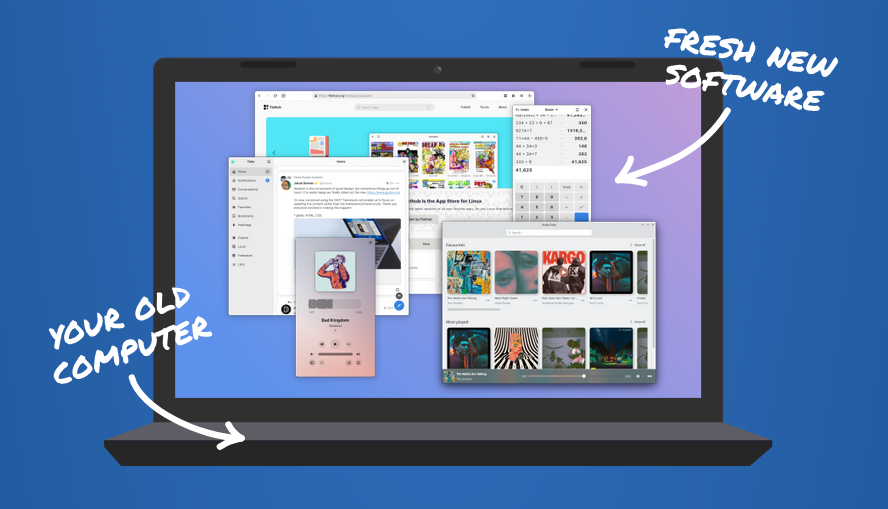The end of Windows 10 is approaching, so it's time to consider Linux and LibreOffice
-
This post did not contain any content.

End of 10
Windows 10 ends in 2025. Don’t buy a new PC — revive yours with Linux. It's fast, secure, and help is available to get you started.
End of 10 (endof10.org)
-
I thought so too, largely on the basis of some very bad experiences with ubuntu-based distributions (they seem to hate my bog-standard RTX3060 GPU for whatever reason), but in frustration I tried one last time to install a linux distro and went with something based on fedora and it has 95% just worked, it's been great. I haven't booted up windows in almost 3 weeks, all my games work (battle.net was a bit of a pain to get working), the proprietary windows software I use for work runs great in wine, etc. I'm at the point now where I'm transferring all my files off of NTFS partitions and reformatting them to btrfs and integrating them into the linux filesystem, cause I'm done with windows forever to the greatest possible extent that I can be.
Nvidia Linux drivers are still kinda iffy these days but so are the Windows ones too
-
This post did not contain any content.
Installed Linux Mint a few months ago and have been dual booting. Hardly use Windows at all now.
Linux is exactly what an OS should be.
-
This post did not contain any content.
What is the highest spec pc I am likely to find for sale when people realise it cant go to windows 11?
-
This post did not contain any content.
I've had windows update disabled for years so the fact that it's "end of life" don't mean shit to me. It'll keep chugging along for years more.
That said, I installed Mint a week ago and love it!
-
I really need to stop putting it off and install Linux on my PC and laptops
How many laptops do you own lol?
-
What is the highest spec pc I am likely to find for sale when people realise it cant go to windows 11?
TMP 2.0 released in October 2014, so I don't think that you can find particularly powerful systems up for grabs.
-
What is the highest spec pc I am likely to find for sale when people realise it cant go to windows 11?
Unless the requirements have changed, you’re looking at 2016-2017 era. Intel 7000-series, AMD Ryzen 1000-series. Newer may be available if there’s no TPM installed.
-
This post did not contain any content.
I just rage-downgraded back to 10 a couple days ago. is there any reason why I shouldn't just keep using it after this year? are we ever going to see a risk for zero day exploits for it like happened for XP after it depreciated?
-
This post did not contain any content.
The only time I use Windows is for Fusion 360
-
That's not the flex you think it is.
Your preoccupation with image here hurts you more than it helps you.
Not that I have a strong opinion one way or the other but Linux people's lack of self awareness or discretion has hurt its spread more than Microsoft has.
Having a teensyweensy bit of occupation with image goes a really long way
-
I just rage-downgraded back to 10 a couple days ago. is there any reason why I shouldn't just keep using it after this year? are we ever going to see a risk for zero day exploits for it like happened for XP after it depreciated?
is there any reason why I shouldn’t just keep using it after this year?
You mean aside from all the reasons not to use Windows that applied even before deprecation? 'Cause there are a fuck-ton of those.
-
This post did not contain any content.
-
It's because LINUX LINUX LINUX LINUX LINUX LINUX LINUX LINUX LINUX LINUX LINUX LINUX LINUX LINUX LINUX LINUX LINUX LINUX LINUX LINUX LINUX LINUX LINUX LINUX LINUX LINUX LINUX LINUX LINUX LINUX LINUX LINUX LINUX LINUX LINUX

GNU! GNU!
-
is there any reason why I shouldn’t just keep using it after this year?
You mean aside from all the reasons not to use Windows that applied even before deprecation? 'Cause there are a fuck-ton of those.
Unironically, yes. I was already aware of those and take them into account
-
I don't understand how can critical buisness machines which work perfectly fine be switched to windows 11?
We have a machine at work which is beefy and works as a server and backups for many many years on windows 10. Why the hell should I upgrade my buisness critical system ?? Why would I take my risk breaking stuff. I am sure there are millions of critical systems running gon windows 10 which should not be distribed at any means, what would Microsoft do about them.
The obvious conclusion is that Windows 10 is not fit for purpose in your business environment and the person in charge of IT procurement dun goofed picking it in the first place.
-
This post did not contain any content.
wishful thinking. i mean i get where the sentiment is coming from, but normal users are going to have a lot of problems if they make that switch. especially if they need particular types of software.
-
You would be amazed in the industrial world. There are tons of large and incredibly expensive special purpose machines that are operated by super antiquated PC architecture computers running geriatric operating systems, sometimes still even DOS or Windows 3.x.
Think industrial CNC mills and lathes, presses, pick-and-place machines, specialty lab testing equipment, electron microscopes, etc.
Process control, i.e. production line automation, is usually driven by dedicated PLCs. But the user interfaces connected to them are almost invariantly some old ruggedized panel mounted PC running Windows. An absurd number of them in my experience are still on 2000 or XP. NT4 is pretty easy to find, too.
Granted often these are not networked, and in cases where they are they're not connected to the internet, or may even talk to other workstations via RS-485 serial (!) or some other gimcrack method that is unlikely to be a vector for modern malware.
Critically, the people who build these machines don't typically update drivers to port them to a new OS. You buy a piece of heavy equipment, investing tens, or maybe even a hundred thousand dollars, and there's an OS it works on, maybe two if you're lucky. The equipment hopefully works for at least 20 years, and basically no OS is going to maintain that kind of compatibility for that long. Linux might get the closest, but I'll bet you're compiling/patching your own kernels before 20 years is up.
This kind of dynamic is unavoidable when equipment vendors sell equipment which has a long usable life (which is good), and don't invest in software support (which is them being cheap, to an extent), and OSes change enough that these time horizons likely involve compatibility-breaking releases.
-
Linux spam is really annoying. Linux users seem to base their entire personality around a goddamn operating system.
I'd rather suck off Bill Gates than be one of those people.
Honestly yes, this entire campaign is absolutely stupid.
-
The only time I use Windows is for Fusion 360
I wish I could make parts in FreeCAD anywhere close to as good as I can in Fusion 360... I REALLY miss it since the move to Linux. I'm not anywhere near as excited about my 3D printer anymore since designing parts is a slog and the end result I am generally un-proud of.
 I feel like my only option (which sucks) is buy a second GPU for pass through and install windows 10 in a VM that only touches the internet once every 2 weeks to keep Fusion happy.
I feel like my only option (which sucks) is buy a second GPU for pass through and install windows 10 in a VM that only touches the internet once every 2 weeks to keep Fusion happy.
-
Simple Wikiclaudia: Chrome extension that finds a simple.wikipedia.org version of any wiki article. If one exists, click to open it; otherwise, it uses Claude or ChatGPT to simplify it.
Technology 1
1
-
PNG has been updated for the first time in 22 years — new spec supports HDR and animation
Technology 1
1
-
-
Millions of Americans Who Have Waited Decades for Fast Internet Connections Will Keep Waiting After the Trump Administration Threw a $42 Billion High-Speed Internet Program Into Disarray.
Technology 1
1
-
-
 2
2
-
-



